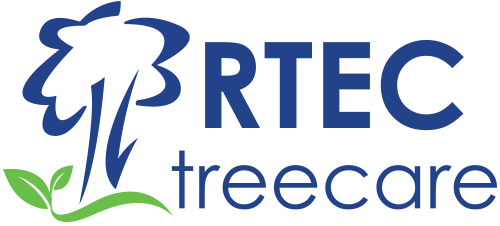Are you a homeowner or gardener who feels like you need to learn more about soil management? Is your soil not up to par or needs a little more loving?
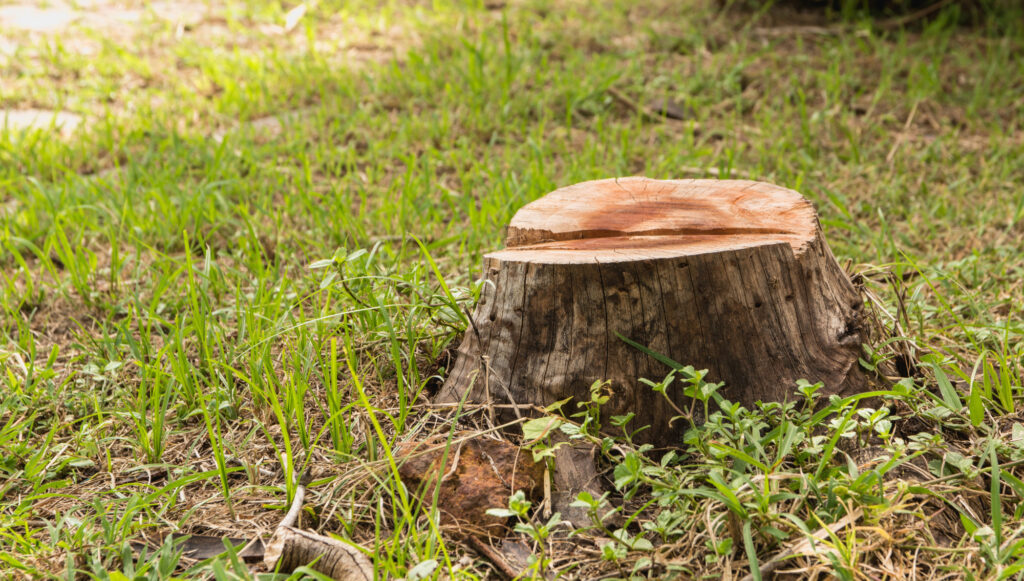
Here’s the thing: Soil management and root management are essential to good tree health. The goal of soil management is to keep the soil composition balanced and enhance the quality of the soil. Soil is comprised of air, water, minerals, and organic matter. Making sure these are balanced is critical to root growth and overall tree health.
Of course, soil management isn’t something most homeowners or gardeners think about when planting flowers, trees, or shrubs in their garden. But if you can focus on your soil biology, it’ll lead to great improvements in your soil structure.
By taking an interest in your tree’s soil management and hiring a professional tree company you can easily keep your soil healthy which is turn creates healthy roots and a healthy tree. And as you well know, anything that improves soil will improve your garden’s health and well-being.
Let’s read on to see five tips that can help you improve your soil biology.
Soil Biology Basics
Have you ever wondered about what goes on underneath the surface of your garden? What creatures, small and smaller, live in there, doing all sorts of miraculous things to ensure your soil structure stays healthy?
Well, your soil contains a complete and complex ecosystem that is delicately balanced and which can be ruined with too much interference from your well-meaning hands.
In many ways, if you can take care of the health of your soil, you will also be taking care of your garden’s health. It’s almost an automatic thing.
Everything you will be doing in soil management has to do with managing nutrients in the soil, managing the little microorganisms that live in the soil, and managing the micro and macropores in the soil.
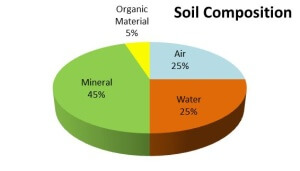 Soil Management – What is Soil Made Of?
Soil Management – What is Soil Made Of?
Soil is made up of four main components; minerals (rock, sand, clay, silt), air, water, and organic matter (matter from dead plants and animals). Typical soils are about 50% solids (45% Minerals, 5% Organic Matter) and 50% pore space which are filled with water and air.
Types of Soil:
There are six main types of soil; clay, sandy, silty, peaty, chalky, and loamy. Each type has different characteristics and will require different tactics of soil management.
Clay:
- Smooth to the touch when dry
- When wet it is sticky to the touch
- Good water storage qualities and holds onto nutrients
- Easily compacted during dry summer months.
Sandy:
- Dry and gritty to the touch when dry
- When wet it crumbles through your fingers
- Has difficulty holding onto water/dries out rapidly
- May lack nutrients
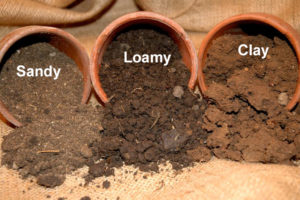
Silty:
- Smooth to the touch when dry
- When wet it’s slick and soapy
- Retains water but easily compacted
Peaty:
- Dark brown or black in color
- When wet it is spongy to the touch and you can squeeze water out of it
- Higher levels of organic matter
- High water retention
Chalky:
- Alkaline
- Stony
- May be lacking minerals such as manganese and iron.
Loamy
- Dark in color
- Soft, dry, and crumbly to the touch
- Typically seen as the best soil
- Drains well but still retains moisture
- Full of nutrients
Here’s The Problem: Urban and suburban landscape trees often reside in soils that are compacted, not the right moisture level, and lack the nutrients needed for growth and development. But don’t worry, you can take steps to help your trees’ soil and root care health.
1. Increase Organic Matter Inputs
Soil organic matter contains many nutrients, the primary ones being nitrogen, phosphorus, and sulfur. How do you add organic matter to the soil? Well, it’s quite easy. Follow what Mother Nature does without our help.
In a natural forest, the leaves and bark from a tree and shrubs fall to the ground and are converted into humus through the diligent effort of microorganisms. That’s what you need to do as well.
Do not clear away the leaves or bark or any other tree droppings. Let them turn into organic matter that sustains and enhances your soil structure.
Also, you can add the following substances to improve organic matter:
- Compost
- Wood Chips
- Mulch
- Leaves
- Sawdust
- Straw
- Hay
- Corncobs
This way you aren’t just depleting your soil of its nutrients, but adding them in regularly.
2. Reduce Pesticide Usage
As mentioned earlier, the microorganisms in the soil, and other little creatures, like beetles, earthworms, and the like, aren’t there just so they can munch on your precious vegetables or flowers.
They actually have a bigger purpose in soil management. Without them, your soil wouldn’t be as nutritious and filled with goodness as it is.
Not only that, but there are lots of beneficial insects, like bees, and such that are crucial to the survival of your garden’s complex ecosystem. That’s why you need to avoid the usage of pesticides as much as possible.
These pesticides might kill some unwanted pests in your garden, but more than that, they end up annihilating all the important microorganisms, and insects as well. This is not good soil management.
Think long-term and stop using pesticides.
3. Perform Farmscaping
Instead of using pesticides, use farmscaping which is an ecological method of increasing the beneficial insects in your garden area and managing biodiversity.
There are many methods you can use in farmscaping, but some of the common ones are:
- Using insectary plants to enhance biological pest control
- Planting hedgerows or cover crops
- Using water reservoirs to attract and support populations of beneficial insects
The main idea with modern soil management techniques is to use the power of Mother Nature in your favor.
Don’t think you know better than Mother Nature who has been performing soil management for centuries without the aid of chemicals, pesticides, or insecticides.
4. Maintain Good Soil pH
Every plant has its own preference in the level of acidity or alkalinity that they enjoy growing in. For example, blueberry likes its soil acidic and only grows in certain states where the soil is extremely acidic.
But in general, your soil management has to include some pH management as well. You don’t want your soil to get too acidic or alkaline if you want to maintain soil nutrients at an optimal level.
A pH of 6 to 7.5 (close to neutral) ensures that all your plants will be able to access soil nutrients easily.
Of course, you will have to make a choice here. Either you choose plants that grow well in this neutral-ish pH or you can alter your soil’s pH to adapt to the plants’ needs. But that means you will be sacrificing your soil biology.
5. Reduce Soil Tilling
Plants need both oxygen and water in the soil to grow optimally. But that doesn’t mean that you excessively tilled the soil because that isn’t good soil management either.
There are two kinds of pores in the soil that you need to be aware of. Macropores are the bigger pores visible and they are necessary for the aeration of the soil during heavy rainfall.
Macropores are created by organisms like ants, dung beetles, and earthworms who move the soil and create the proper soil structure necessary for plant growth.
The smaller pores or micropores are necessary for holding and absorbing water.
When you excessively till the soil, it breaks apart these macropores and micropores so that the soil isn’t able to hold and absorb water properly.
As you become more aware of the nuances of soil management, you will learn intuitively when to till the soil and when to leave it alone.
Soil Management Is All About Maintaining Natural Soil Biology
Optimal soil management is all about letting nature take its course as much as possible. The more humans interfere in their unknowing ways, the further we can damage the delicate ecology that is your soil structure.
Use natural measures primarily to build your soil biology, as this improves the soil in a manner that doesn’t harm the ecosystem that’s thriving under the surface unseen by you.
Are you looking to protect your tree and shrubs? RTEC Treecare has a multitude of tree services that can help you out.
Soil Problems & Solutions!
Have a hunch your trees are already experiencing soil or root related issues? Don’t worry, we’ve got you covered. Here are the common soil and root issues, and the solution to each of them.
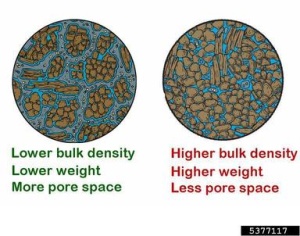 1. Soil Compaction -> Soil Aeration
1. Soil Compaction -> Soil Aeration
In most urban and suburban areas the soils are very compacted, typically due to construction or high traffic which is why soil management is so important. For example in forests, the top 6 inches of soil is 50% oxygen. However; the average urban soil is only 10% oxygen. This lack of oxygen and pore space doesn’t allow enough water, oxygen, or nutrients to reach the tree’s roots. This can create problems for root growth and the health of the tree overall.
Symptoms of Compaction:
- Overall decline in the tree’s health
- Canopy dieback
- Presence of Secondary invaders(insects & diseases)
- Areas under the canopy where grass doesn’t grow
Compaction Treatments – Soil Management:
Aeration: We use high-velocity air tools and techniques to properly aerate the tree’s critical root zone (CRZ) loosening the soil. This creates macro and micropore space, making room for root growth.
2. Lack Of Nutrients In Soil -> Biostimulants
Trees are living organisms and require nutrients to grow and survive. Trees in the forest have an abundance of nutrients because of the delicate forest environment that has evolved over millions of years. The trees in our yards; however, are a whole other story. As we rake away leaves, twigs, and fallen bark we remove nutrients that would have naturally decomposed and entered the soil, feeding the tree.
To ensure your tree has all the nutrients it needs our Arborists recommend fertilizing your tree using bio-stimulants as a form of soil management.
Bio-Stimulants – Soil Management: This mixture contains a natural blend of sugars, bacteria, humic acid, sea kelp extract, and fungi. This mix is great for soil management because it naturally fertilizes the tree without throwing off the soil balance. By introducing this blend to the critical root zone it will re-establish good soil composition and act as a multi-vitamin for your tree.
If your tree is suffering from nutrient deficiencies and compaction our arborists may recommend Vertical Mulching as a form of soil management.
Vertical Mulching – Soil Management: This process is similar to de-compaction but goes one step further. Vertical mulching uses the same high-velocity air tool, as de-compaction does, but the technician creates holes every 2 to 3 inches in the critical root zone. These holes are then filled with organic matter which permeates improves the overall composition.
3. Too Much Or Too Little Soil Moisture -> Revise Your Watering Technique
Water is essential to the health of trees. But just like all the other aspects of soil management, it is important to find a balance.
Too Little Moisture:
- Compaction
- Drought Stress
- Wilting of leaves
- Yellowing/browning of leaves
- Thinning of Canopy
Soil Management: If your soil is too dry make sure you are watering deeply and thoroughly 1 to 2 times a week. Take your cues from your trees soil. You want it to be moist but not soaking. You should NOT be able to make a mud ball out of the soil. It’s also okay for some portions of the soil to be wet and some to be dry.
Instead of using a sprinkler try turning your hose to a dribble and leaving it in the critical root zone for 2-3 hours. Every couple of hours move the hose to a different location. This will give you a deeper and more thorough watering than if you were to turn the hose on full blast and drench the soil for 10 minutes. Learn More About Proper Watering
Too Much Moisture:
- Fungal issues (fungi love over moist soils)
- Low oxygen levels
- Defoliation
- Droopy Foliage
- Branch & Root Dieback
- Chlorosis (Yellowing of Leaves)
- Washes nutrients out of the soil
Learn more about how too much water can hurt your trees.
Soil Management: If your tree’s soil is too moist take a break from watering for a couple days. If you’re still having issues with too much moisture (and it hasn’t been an especially rainy week) you may need to invest in a drainage system. If you can’t fix this issue through soil management, you can also look for trees and shrubs that like very wet soils and aren’t prone to fungal diseases.
4. Root System Issues -> Root Collar Excavation & Root Care Package
The root system of the tree is the most important part of its structure. Unhealthy or diseased roots will cause tree failure, making the tree a hazard. Most problems are not visible without the process of air spading (exposing the tree roots).
Root Collar Excavation: When trees are showing signs of possible root issues our Arborist will most likely recommend a root collar excavation. In this process, we will use high-velocity air tools to blow away the soil and expose the roots. This then allows the Arborist to diagnose the tree’s root issues and describe what management is needed. Our tree service experts will be able to put together a soil & root care package for you that is customized to your needs
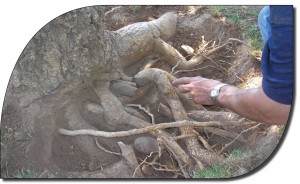
Girdling Root Syndrome
The most common problem with roots in our area is Girdling Root Syndrome (GRS). GRS is typically found in trees that were planted with burlap/wire baskets or planted in walkways /near concrete. Often times these roots struggle to survive in such small areas and end up “choking” and “strangling” themselves rather than being able to spread out and expand far out into the ground.
GRS Management: To solve this problem girdling roots are hand pruned to avoid tearing and to help release pressure and allow the tree’s roots to grow.
Do you need help with your tree’s soil and root care? Our team of Certified Arborists and tree service experts are here to help. To get a free estimate, you can book an appointment online or call us at 703.573.3029.
